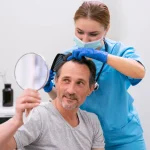Dealing with head lice is a nightmare for anyone—whether you’re a parent, a student, or just someone unlucky enough to catch them. The discomfort, the itching, and the sheer hassle of getting rid of these tiny pests can make anyone desperate for a quick fix. Among the many DIY solutions floating around, one intriguing idea stands out: Can hair straighteners kill nits?
At first glance, it seems logical. Hair straighteners reach high temperatures—hot enough to fry a bug, right? But does this method really work? Let’s explore the science, expert insights, and effective alternatives to help you make an informed decision.
| Method | Effectiveness | Pros | Cons | Best For |
|---|---|---|---|---|
| Hair Straightener | ❌ Not reliable for nits | Can kill some adult lice | Risk of burns, hair damage, doesn’t reach scalp nits | Not recommended |
| Over-the-Counter Lice Treatments | ✅ Effective | Kills lice & some nits | Some lice may be resistant, requires multiple applications | General lice treatment |
| Lice Combs | ✅ Very effective for nits | Removes nits manually, no chemicals | Time-consuming, requires patience | Removing stubborn nits |
| Professional Lice Removal | ✅ Highly effective | Done by experts, ensures complete removal | Can be expensive | Severe or persistent infestations |
| Home Remedies (Coconut Oil, Tea Tree Oil, etc.) | ⚠️ Somewhat effective | Natural, gentle on hair | Not always reliable, requires repeated use | Mild cases or prevention |
This table makes it easier for readers to compare methods at a glance. Let me know if you’d like any modifications!
What Are Nits and Why Are They So Hard to Kill?
Before we dive into the straightener debate, let’s understand what we’re dealing with.
Nits are the eggs of head lice. These tiny, oval-shaped eggs cling tightly to hair shafts near the scalp, thanks to a glue-like substance secreted by the female louse. This makes them incredibly difficult to remove.
A nit typically takes about a week to hatch into a nymph (baby louse), which then matures into an adult within another week. Unless you stop this cycle effectively, lice will keep coming back.
Key reasons nits are tough to eliminate:
- They are firmly attached to hair, making them hard to comb out.
- They blend in with hair color, making them difficult to spot.
- The scalp’s warmth protects them, helping them hatch successfully.
So, where do hair straighteners come in? Let’s find out.
Can Hair Straighteners Kill Nits?
Hair straighteners reach temperatures of 300°F (150°C) or higher, which is enough to kill many insects. Logically, they should be able to destroy lice and their eggs. However, there are key challenges to this method.
1. Heat Might Not Reach the Scalp
Most nits are laid close to the scalp, where a straightener can’t reach without causing burns. Even if you straighten your entire hair, you might miss the ones near the roots, leaving the infestation intact.
Dr. Elizabeth Warren, an entomologist, explains: “While hair straighteners can reach temperatures lethal to adult lice and nymphs, the challenge lies in ensuring even heat distribution and reaching areas close to the scalp without causing burns.”
2. The Hard Shell of Nits Provides Protection
Nits have a protective outer shell designed to withstand external threats. While direct heat can kill some, not all nits will be exposed to enough heat to be destroyed completely.
3. Lice Move Quickly
Even if you manage to kill some nits, adult lice can quickly relocate, escaping the heat. This means the infestation may continue despite using a straightener.
The Risks of Using Hair Straighteners for Lice Removal
Beyond questionable effectiveness, using hair straighteners for lice removal comes with real risks.
1. Hair Damage
Excessive heat can lead to:
- Dryness and breakage
- Split ends
- Weakened hair structure
As hairdresser Maria Lopez warns: “Hair straighteners can damage your hair if used excessively. There are safer and more effective methods to treat head lice, such as specialized lice shampoos or combing.”
2. Risk of Burns
Trying to press a straightener close to the scalp increases the risk of burns, especially in children.
3. It’s Not a Long-Term Solution
Even if some nits die, new ones can hatch, and the problem persists. Without a thorough removal strategy, lice will return within days.
Effective Alternatives for Removing Lice and Nits
If hair straighteners aren’t the answer, what works better? Here are proven methods:
1. Over-the-Counter Lice Treatments
Many lice shampoos contain permethrin or pyrethrin, which effectively kill both lice and nits. However, some lice have developed resistance, so read reviews before purchasing.
2. Lice Combs: Your Best Friend
A fine-toothed lice comb is one of the most effective ways to remove nits. Regular combing can physically pull nits and lice out of the hair, preventing further spread.
Lice expert Maria Lopez advises: “A fine-toothed lice comb is essential for removing lice and nits. It’s a safe and effective method that can be used in conjunction with other treatments.”
3. Professional Lice Removal Services
If you want a foolproof solution, professional lice removal services use specialized tools and techniques to ensure complete eradication.
4. Natural Remedies (Use with Caution)
Some people swear by home remedies like:
- Coconut oil – Believed to suffocate lice
- Tea tree oil – Has insecticidal properties
- Vinegar rinses – May help loosen nit glue
While these might help, they aren’t always 100% effective on their own.
My Personal Experience: A Lesson Learned
I remember a time in high school when my younger sibling came home with lice. Desperate to avoid catching them myself, I grabbed my straightener and went to work. After spending hours flat-ironing my hair, I felt confident I had zapped every nit.
A week later, I was scratching my scalp like crazy. It turns out I had missed some nits near my roots, and they had hatched. The straightener didn’t prevent reinfestation, and I ended up having to use a lice comb and treatment anyway.
Moral of the story? Quick fixes rarely work.
Why Proper Treatment Matters
Lice don’t go away on their own, and ignoring them can:
- Increase infestation severity
- Lead to secondary skin infections from scratching
- Spread to family members and friends
Dr. Sarah Cohen, a pediatrician, advises: “While a hair straightener might kill some lice, it’s not a reliable or safe method. Using over-the-counter lice treatments or consulting a professional is recommended.”
Final Verdict: Can Hair Straighteners Kill Nits?
Technically, yes. But practically, no.
While hair straighteners can generate enough heat to kill lice and some nits, they are unreliable, risky, and can damage your hair. More effective and safer alternatives, such as lice combing, medicated shampoos, and professional treatments, should be your go-to solutions.
So, if you’re battling head lice, put down the straightener and pick up a lice comb instead. Your scalp—and your hair—will thank you!
Key Takeaways:
✅ Hair straighteners can kill some lice and nits, but they’re not a reliable solution.
✅ Nits near the scalp are hard to reach with heat without causing burns.
✅ More effective methods include lice combs, medicated shampoos, and professional removal services.
✅ Don’t risk hair damage and burns—opt for proven treatments.
✅ Consistency is key to completely eliminating lice and preventing reinfestation.




